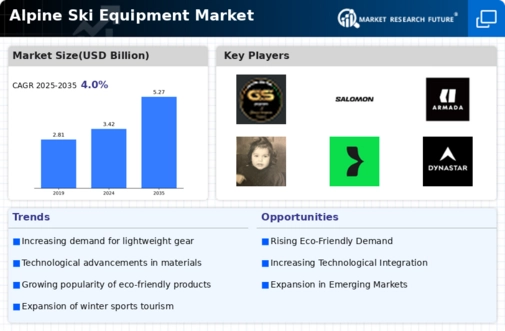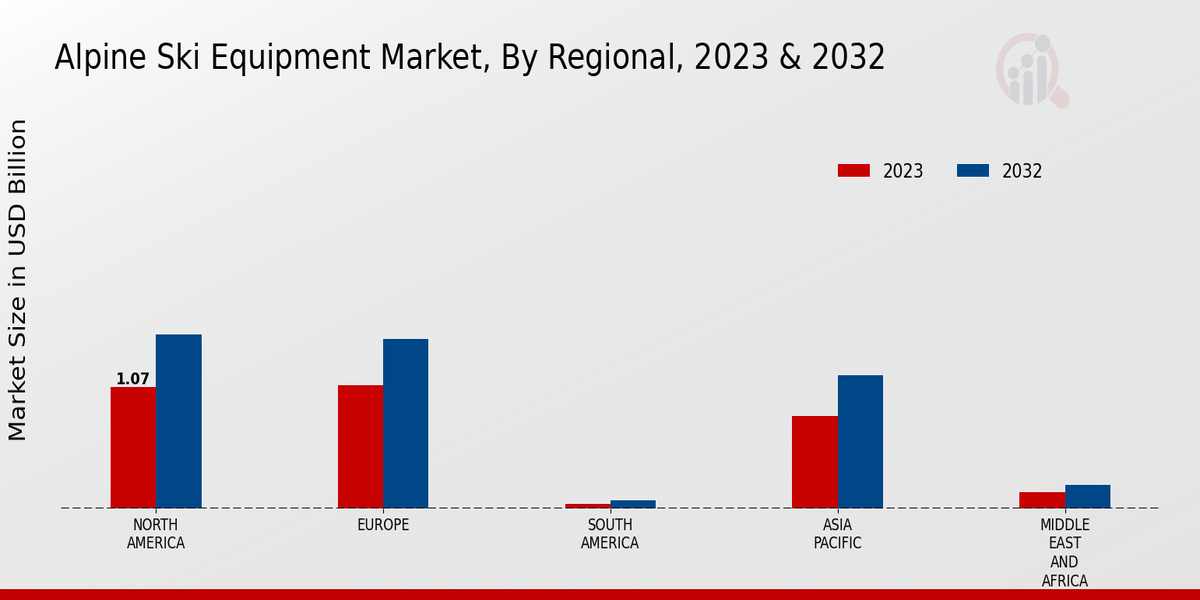Growing Popularity of Ski Resorts
The proliferation of ski resorts worldwide significantly influences the Global Alpine Ski Equipment Market Industry. As new resorts emerge and existing ones expand their offerings, more individuals are drawn to skiing as a recreational activity. This trend is particularly pronounced in regions such as North America and Europe, where ski tourism thrives. The increasing number of resorts enhances accessibility to skiing, thereby boosting equipment sales. The market's expected growth rate of 4.02% CAGR from 2025 to 2035 underscores the potential for sustained expansion driven by the allure of ski resorts.
Technological Advancements in Equipment
Technological innovations play a pivotal role in shaping the Global Alpine Ski Equipment Market Industry. Manufacturers are increasingly integrating advanced materials and designs to enhance performance and safety. For example, the introduction of lightweight materials and improved binding systems has revolutionized the skiing experience. These advancements not only attract seasoned skiers but also appeal to novices seeking reliable and efficient equipment. As the industry evolves, the anticipated market growth to 5.27 USD Billion by 2035 indicates a strong correlation between technological progress and consumer demand for superior skiing gear.
Increasing Participation in Winter Sports
The Global Alpine Ski Equipment Market Industry experiences a notable surge in participation in winter sports, driven by growing interest among various demographics. As more individuals engage in skiing, the demand for high-quality ski equipment escalates. This trend is particularly evident in regions with established ski resorts, where participation rates have increased significantly. For instance, countries like Switzerland and Austria report a steady rise in skier numbers, contributing to the market's growth. The projected market value of 3.42 USD Billion in 2024 reflects this increasing engagement, suggesting a robust future for the industry.
Environmental Awareness and Sustainability
The Global Alpine Ski Equipment Market Industry is witnessing a shift towards environmentally friendly practices, as consumers become more conscious of sustainability. Manufacturers are responding by developing eco-friendly ski equipment, utilizing sustainable materials and production methods. This trend not only aligns with consumer values but also enhances brand loyalty among environmentally aware skiers. The industry's commitment to sustainability is likely to attract a broader audience, contributing to the projected market growth. As the market evolves, the emphasis on eco-conscious products may play a crucial role in shaping future purchasing decisions.
Increased Investment in Winter Sports Infrastructure
Investment in winter sports infrastructure is a significant driver for the Global Alpine Ski Equipment Market Industry. Governments and private entities are channeling resources into enhancing ski facilities, which in turn stimulates interest in skiing. Improved infrastructure, such as upgraded lifts and expanded trails, creates a more appealing environment for skiers. This influx of investment not only boosts participation rates but also encourages the purchase of new equipment. The anticipated growth trajectory of the market, reaching 5.27 USD Billion by 2035, suggests that infrastructure development will continue to play a vital role in the industry's expansion.






















Leave a Comment